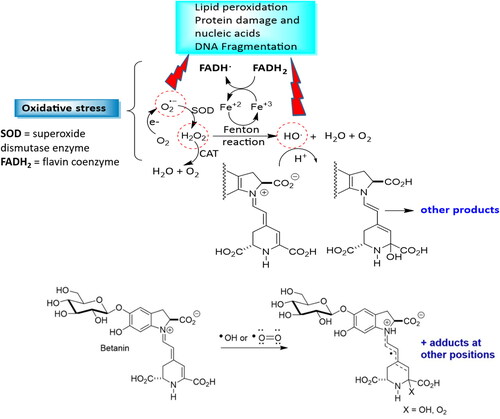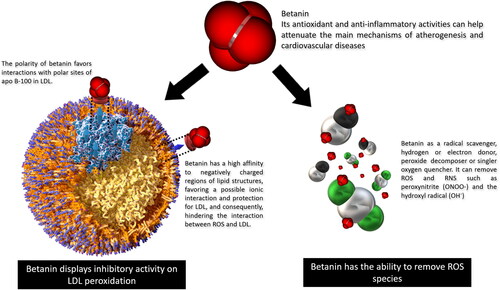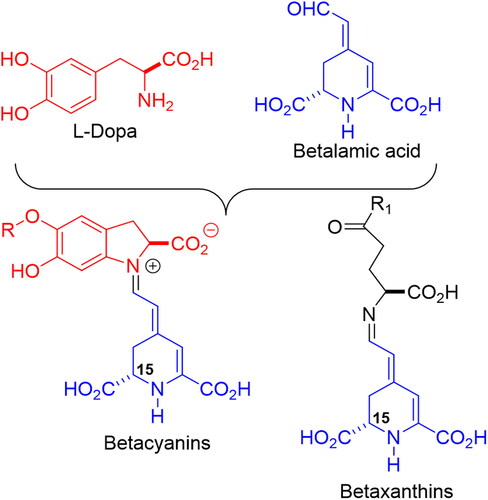Figures & data
Figure 3. Structural betanin modifications in the gastrointetinal tract and bloodstream. Panel A: Ionic states of betanin at a pH range from 2 to 9. Panel B: Probable ionic states of betanin, phenolic O-H homolytic bond dissociation energy and ionization potential energy according to the pH of gastrointestinal tract fluids and the bloodstream.

Figure 4. Betanin as a radical scavenger, hydrogen or electron donor, peroxide decomposer or singlet oxygen quencher. O2 leakage from mithocondria generates the superoxide anion radical O2•-, which is converted to H2O2 by superoxide dismutase (SOD). Both, O2˙- and H2O2 can cause damage to cellular components. H2O2 can be cleaved to the radical by iron-sulfur clusters found in several metalloproteins (e.g. ferredoxins, NADH dehydrogenase, hydrogenases, coenzyme Q) by increasing Fe2+ in the cytosol. Fe2+ reacts with H2O2 through the Fenton reaction, generating HO•, which causes serious oxidative damage. Fe3+ is then reduced back to Fe2+ by flavoproteins (FADH2) to generate oxidized flavin radicals (FADH) and the hydroxyl radical. Betanin can also couteract with •OH or •O = O radicals forming several adducts.

Table 1. Betanin effects on experimental models mimicking risk factors for CVD: Evaluation of direct and indirect antioxidant and anti-inflammatory effects.
Figure 5. Betanin attenuates LDL peroxidation. Betanin antioxidant and anti-inflammatory activities can attenuate the main atherogenesis mechanisms, protecting against CVD. Betanin free-radical scavanger activity removes ROS and prevents LDL peroxidation. Betanin in the bloodstream is able to establish ionic interactions with the polar head of phospholipids and to Tyr reisdues in apoB-100, avoinding tyrosine generation and LDL agregation.

Figure 6. Putative effects of betanin on the redox sensitive Nrf2-ARE and NF-kB pathways. Panel A -The transcription factor Nrf2 is bound to Keap1 in the cytoplasm, and the Nrf2-Keap1 complex dissociation allows for Nrf2 translocation to the nucleus. In the nucleus, Nrf2 dimerizes with the Maf protein and binds to ARE sequences in the promoter of genes that encode phase II detoxification and antioxidants enzymes. Betanin can down-regulate Keap1 expression and/or modify Cys residues culminating in the dissociation of Nrf2, which, in turn, translocates to the nucleus. Betanin can also cross-link the two pathways by up regulating the expression of Nrf2 in the nucleus, favoring the transcription of antioxidant/cytoprotective genes. Panel B -The NF-kB transcriptional factor is synthesized and constitutively linked to the inhibitory protein IkBα in the cytoplasm. The dissociation of the IkB-NF-kB complex occurs by phosphorylation of IkB by IKK kinases which are then activated in response to ROS and oxidative stress. IkB phosphorylation results in its ubiquitination and dissociation of NF-kB, which translocates to nucleus. The activated NF-kB binds to the promoter of target genes, activating the transcription of inflammatory cytokines, chemokines and adhesion molecules. Betanin acts directly on ROS and on antioxidant genes, subsequently inhibiting the activation of IKK, avoiding IkB phosphorylation and release of NF-kB to the nucleus. Thus, betanin, through its role on the dissociation of Keap1-Nrf2, makes Keap1 free for inhibitory binding with IKK. Legend: ARE – Antioxidant response element, BET betanin, BTB bric-à-brac protein, CAT – catalase, COX-2 – cyclooxygenase 2, Cys – cysteine residues, GPx – glutathione peroxidase, GR – glutathione reductase, HO-1 – heme oxygenase 1, IKK – ikB kinase, iNOS – inducible nitric oxide synthase, IL – interleukins, IVR – intervening region, keap1 – Kelch-like ECH-associated protein 1, Maf – small musculoaponeurotic fibrosarcoma protein, Nrf2 – nuclear factor erythroid 2-related factor 2, NF-kB – kappa B nuclear factor, P – phosphorylation, SOD – superoxide dismutase, TRX – thioredoxin, TNF-α – tumoral necrosis factor alpha.



